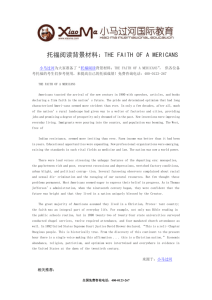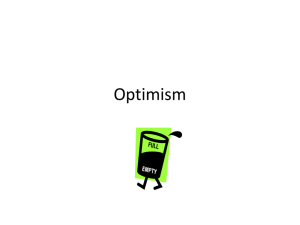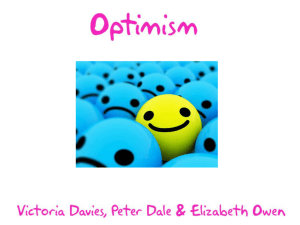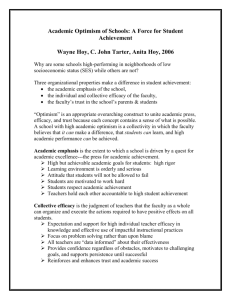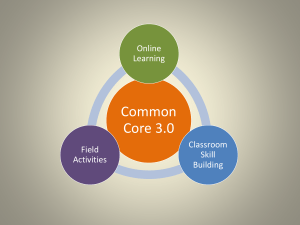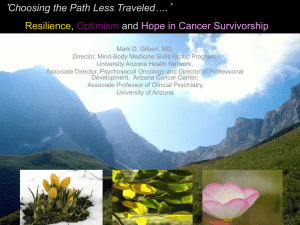Cultivating Optimism in the Classroom
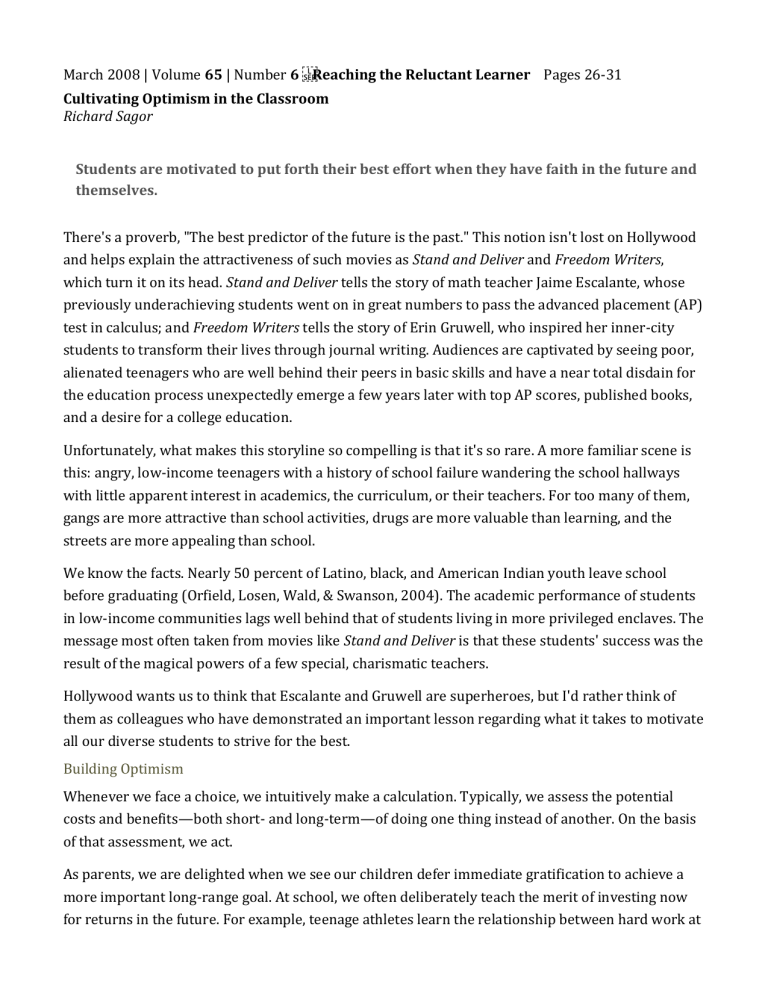
March 2008 | Volume 65 | Number 6
Cultivating Optimism in the Classroom
Richard Sagor
Students are motivated to put forth their best effort when they have faith in the future and themselves.
There's a proverb, "The best predictor of the future is the past." This notion isn't lost on Hollywood and helps explain the attractiveness of such movies as Stand and Deliver and Freedom Writers, which turn it on its head. Stand and Deliver tells the story of math teacher Jaime Escalante, whose previously underachieving students went on in great numbers to pass the advanced placement (AP) test in calculus; and Freedom Writers tells the story of Erin Gruwell, who inspired her inner-city students to transform their lives through journal writing. Audiences are captivated by seeing poor, alienated teenagers who are well behind their peers in basic skills and have a near total disdain for the education process unexpectedly emerge a few years later with top AP scores, published books, and a desire for a college education.
Unfortunately, what makes this storyline so compelling is that it's so rare. A more familiar scene is this: angry, low-income teenagers with a history of school failure wandering the school hallways with little apparent interest in academics, the curriculum, or their teachers. For too many of them, gangs are more attractive than school activities, drugs are more valuable than learning, and the streets are more appealing than school.
We know the facts. Nearly 50 percent of Latino, black, and American Indian youth leave school before graduating (Orfield, Losen, Wald, & Swanson, 2004). The academic performance of students in low-income communities lags well behind that of students living in more privileged enclaves. The message most often taken from movies like Stand and Deliver is that these students' success was the result of the magical powers of a few special, charismatic teachers.
Hollywood wants us to think that Escalante and Gruwell are superheroes, but I'd rather think of them as colleagues who have demonstrated an important lesson regarding what it takes to motivate all our diverse students to strive for the best.
Building Optimism
Whenever we face a choice, we intuitively make a calculation. Typically, we assess the potential costs and benefits—both short- and long-term—of doing one thing instead of another. On the basis of that assessment, we act.
As parents, we are delighted when we see our children defer immediate gratification to achieve a more important long-range goal. At school, we often deliberately teach the merit of investing now for returns in the future. For example, teenage athletes learn the relationship between hard work at
practices and success at the game on Friday night. Other students elect to do well in school out of a firm belief that getting good grades will lead to admission to a selective college, which will lead to a happy adult life.
We might wonder why this calculation isn't convincing for all students. Why aren't they buying in?
The reason is simple: Investing today for a payoff tomorrow requires believing in your future. Put succinctly, motivation requires optimism.
Sometimes it appears that optimism—a positive belief in the future—is a genetic trait. This is one explanation for why children of successful people tend to be successful themselves. And, conversely, it helps explain why children from families that must continually struggle to just get by often find themselves engaged in similar struggles on reaching adulthood.
But the good news, dramatically demonstrated by teachers like Jaime Escalante and Erin Gruwell, is that optimism can be taught and learned. Two key variables are the building blocks of optimism: faith and efficacy.
Building Block 1: Faith in the Future
For me to invest time and energy today for a benefit I won't realize until tomorrow, I need to have a good reason to believe that my investment will pay off. Clearly, it's much easier to acquire that faith when one's immediate environment regularly shows concrete evidence of return on investment.
John Ogbu (1991) has written extensively about how children tend to look to the experience of adults in their communities and extended families to predict what lies ahead for them.
If children see despair around them, it's likely that they will fear that this represents their destiny.
Many children simply have no good reason to expect tomorrow to be any better than today. There are many legitimate reasons for despair: the impact of poverty, chemical dependency, bigotry, family break-ups, and so on.
If the picture is rosier, however, children have a better chance of being optimistic about their futures. One powerful demonstration of the positive influence of faith in the future was the experience of philanthropist Eugene Lang (White, 1987), the founder of the "I Have a Dream"
Foundation. In an impromptu speech, Lang promised a free college education to 61 6th graders at a
New York public school if they stayed in school and graduated. Although statistics showed that 75 percent of the students wouldn't go on to graduate from high school, more than 90 percent of
Lang's dreamers graduated, with more than two-thirds attending college. What these students had lacked was sufficient reason to believe in their futures. Once they had a justification for faith, they did what it took to realize success.
Building Block 2: Personal Efficacy
In general, it takes more than faith to commit to a difficult pursuit. Optimistic people have the fortitude to persevere with complex tasks because they are confident that if they work long and
hard enough and apply enough creativity, they will, in fact, succeed.
Efficacy is a deep-seated belief in our own capabilities. It explains the phenomenon of success breeding success. Every time people attack a problem and succeed, they have authentic evidence of their capability. The more data I have about my capabilities, the more confident I will be of my potential to achieve future success.
Early in my teaching career, I decided to expect every student to produce work deserving of an A or
B; otherwise, his or her grade would be NYE—not yet excellent. Occasionally it took extra time, but every student was ultimately able to leave my class with evidence of his or her capability.
There's a reason why so many parents love the story of The Little Engine That Could. We all know that if someone keeps hearing a credible inner voice repeating, "I think I can, I think I can, I think I can," that person will start believing it.
Building Faith and Efficacy in School
Empowered Preschoolers
My daughters went to the Montessori preschool in the local Catholic church. They loved it, as did all their classmates, and they happily got up each morning to go to school. Donna Hargraeves was their teacher, and in her classroom, the children had continual opportunities to explore and learn. She directed the students to activities at a level at which, with effort, they could achieve success.
I can still vividly recall the first open house we attended. I was expecting to hear a teacher presentation, receive handouts, or engage in a conference with the teacher. It was nothing like that.
As I entered the room, it looked no different from when I dropped Ellisa off each morning. An aide greeted my daughter and handed her a 3 × 5 index card that listed all the lessons she had mastered.
She was then invited to show us what she could do.
For the next 40 minutes, Ellisa led us around the room and treated us to demonstrations of things she had learned. Her pride in her accomplishments was palpable, and as I looked around, I saw the same scene repeated child after child. It was clear to me that the teacher was developing optimism in that room every day with every child.
This was my first experience with student-led parent-teacher conferences, this one brilliantly directed by a 4-year-old. In 40 minutes, I learned more about what my daughter could do, what she had accomplished, and what she was still working on than I ever could have gotten from a traditional conference. But, most important, I witnessed the development of a powerful sense of efficacy on Ellisa's part. She was sharing her accomplishments, which were the result of her efforts, and she was deservedly beaming with pride and confidence.
Now a junior in college, Ellisa takes on any challenge placed in front of her. There is no doubt in my mind that those crucial early experiences in Donna Hargraeves's classroom empowered her with
the conviction that when she sets her mind to something, she can do it.
Sixth Grade Astronauts
Every May at Liberty Middle School in Camas, Washington, approximately 125 6th graders spend a long 10-hour day in space. This extraordinary simulation is a collaborative project that has evolved over several years.
Each space station crew includes five specialists—a mission commander, a life sciences specialist, a health and nutrition specialist, a robotics specialist, and a communications officer. Immediately after spring break, students must prepare written applications for at least two different positions.
The teachers then select students for the five crews, and over the next 10 weeks, the students prepare for the mission. At times, all the students who have the same position work with one another in a group—all the mission commanders meet, all the life sciences specialists meet, and so on. At other times, students work with their crewmates, training for the work required during their day in space.
When parents bring their kids to school on the morning of the mission, the gymnasium is a sight to behold. In one corner is mission control, a bank of computers, monitors, and microphones from which the teachers and mission control officers (older students who have been through the program) monitor the astronauts' work. Most of the gym is filled with the space station, which is made up of six connected modules. Soon the students don their spacesuits and gather for the preflight briefing from their teacher. Then, like clockwork, every five minutes another crew enters the space shuttle for the short flight to the International Space Station. For the next 10 hours, the only people each crew will interact with are fellow crew members and mission control.
The five crews rotate through the different modules and carry out their work without ever seeing or interacting with one another. They prepare and eat food in the galley, manipulate objects outside the spacecraft with robotic equipment, conduct experiments on plants and animals, observe rest periods, and even follow exercise routines to keep fit.
The day in space ends with a press conference conducted from the space station. Parents and guests get to see their children on the monitors and listen as the "astronauts" describe what transpired and what they learned on their long and grueling mission. After the press conference, the astronauts board the shuttle and return to earth.
The teachers have structured this 10-week experience in a manner that enhances the academic program rather than detracts from it. Each crew member must do a great deal of reading, writing, math, science, and social studies to prepare for the mission; and this intensive training pays off.
Invariably, the mission succeeds, and the crews do their work well. Most important, each crew member possesses concrete evidence of his or her success as a leader, learner, and teacher, engendering a powerful sense of optimism. This optimism lasts quite a while; several former 6th
grade astronauts are now in college studying aerospace.
Middle School Reformers
At a large middle school in Southern California that serves a racially, economically, and ethnically diverse community, an English teacher and a doctoral student invited interested students to join them as coresearchers in an investigation of the obstacles to learning at their school (SooHoo,
1993). Twelve students agreed to meet for regular lunchtime discussions. The student researchers were mostly a diverse group of immigrant and minority students, with several English language learners among them. These students weren't particularly comfortable with their place in society or school. Armed with cameras and sketch pads, the students set out to record areas of concern and discuss them at their lunch meetings.
After a few months of deliberation, the student researchers began to see a pattern in their data.
Some aspects of the school program weren't working as well as they should. Students had ideas about changing the school's discipline and reward policy as well as the physical education program.
They began developing ideas for program improvement.
They soon realized that they lacked power to bring about the desired changes. Together with their adult mentors, the students requested the opportunity to present their research to the faculty. In a faculty meeting at which they served cookies, cupcakes, and soft drinks, the students presented their research. Later that spring on a scheduled professional development day, the 12 students were invited to work side by side with their teachers in making plans for the new school year. On the basis of the students' input, the school revised the discipline and reward process and redesigned the physical education program.
I met these students a few years later when they presented their research to an audience of university professors at the annual American Educational Research Association conference. The students—now high school sophomores—were articulate, confident, and absolutely certain they were headed to college and professional careers. After they learned as middle school students that they had powerful voices and were capable of persuading adult professionals with their arguments, nothing could stop them from achieving their goals.
An Environmental Advocate
A high school student named Sam recently became interested in the movement to design and build environmentally sound "green" buildings. He was not a good student academically, had few friends and little status, and didn't fit in with or have much respect for the social activities that defined the traditional high school experience.
But he didn't lack confidence. He went to the high school administrators with an elaborate written proposal describing an independent study he wanted to do on the potential conversion of a recently built public building to meet green building standards. He worked hard on his proposal and was
excited about pursuing this work. Unfortunately, the school didn't see it the same way. As a result,
Sam decided to leave to attend a nearby alternative school in the hope that its community-based learning model might be a better fit.
The teachers' reaction to his proposal at the alternative school was markedly different. The school made arrangements for Sam to intern at one of the largest and most prestigious architectural firms in the region. One day in a meeting with several of the firm's top architects, a lead architect commented that the constraints of school construction limited possible energy efficiencies.
Sam spoke up. His research had revealed that six buildings recently built in Los Angeles now operated completely off the grid. Impressed, the architects asked Sam to do more research. The next day Sam presented this "new information" to some of the leaders in the field.
Sam has now graduated and is making plans to attend college. Although he readily admits that he is the proverbial square peg that people try to push through a round hole, he has no doubt about his ability to accomplish whatever he sets his mind to.
Great Expectations
It is naïve to think there could be an easy answer to all our student motivation problems. But one thing is clear: Young people are more likely to invest their energy in pursuit of what they view to be an achievable dream than in what they sense is futility.
That's why students need continuous encouragement and hope from schools—so they can believe in their futures and themselves. Every day as students leave our classrooms we need to ask ourselves two questions: As a result of today's experience, will these students be more or less confident that their futures are bright? Will students walk out of the classroom feeling more more capable than when they walked in?
Every morning an alarm clock goes off, a student awakes, and thoughts begin to form. What should the student expect from the upcoming day? If he or she were lucky enough to have had a teacher like Jaime Escalante or Erin Gruwell, or had been promised a college education by Eugene Lang, that student may well be looking forward to a bright future. But optimism shouldn't depend on having a superhero as a teacher or on receiving help from a philanthropist. We teachers can nurture optimism in all our students by creating routine education experiences in which hard work leads to success and a world of possibilities.
References
Ogbu, J. U. (1991). Immigrant and involuntary minorities in comparative perspective. In
M. A. Gibson & J. U. Ogbu (Eds.), Minority status and schooling: A comparative study of
immigrant and involuntary minorities (pp. 3–33). New York: Garland.
Orfield, G., Losen, D., Wald, J., & Swanson, C. B. (2004). Losing our future: How minority
youth are being left behind by the graduation rate crisis. Cambridge, MA: The Civil Rights
Project at Harvard University. Available: www.urban.org/uploadedPDF/410936_LosingOurFuture.pdf
SooHoo, S. (1993). Students as partners in research and restructuring schools. The
Educational Forum, 57(4), 386–393.
White, J. (1987). Eugene Lang: Dreammaker to the kids of Harlem. AGB Reports, 29(3), 10–17.

